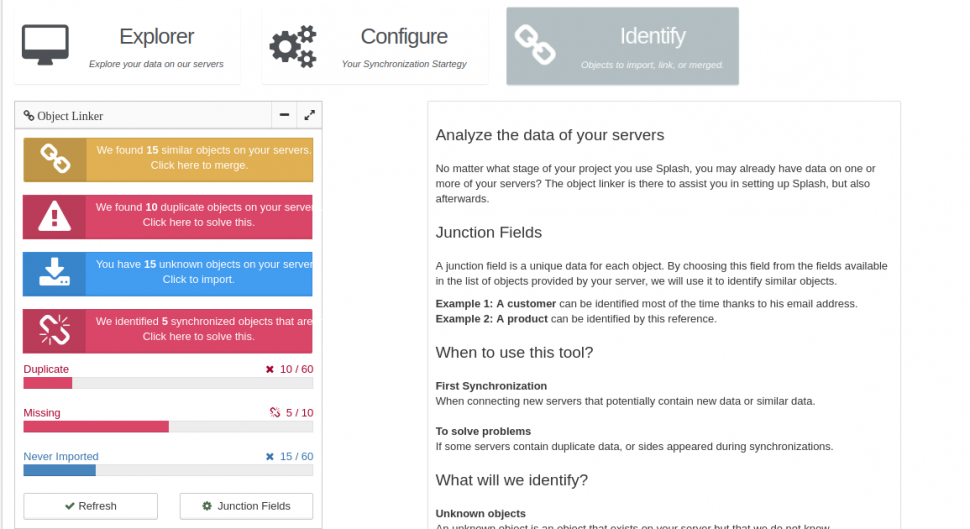Analyze data between your Servers
Analyze your servers data
The data analyzer is there to assist you in setting up Splash, but also afterwards.
No matter what stage of your project you use Splash, you may already have data on one or more of your servers? The analyzer is there to allow you to quickly identify the actions to perform on your data to ensure that they are fully synchronized.
The analysis is done in the background by the Splash servers. During this analysis, we will download, from each of your servers, the list of all available data.
All this data will then be analyzed to identify any problems and/or improvements that Splash can offer.

When to use this tool?
- First Synchronization
-
When you connect new servers that already contain data, it is important to use the analyzer to identify similar objects. For example, if you are connecting two systems that already have products in their catalogs, it is important that Splash know which products are similar before any synchronization operation. So you avoid mistakes and creating potential duplicates. It is also important, when you start with Splash, to import existing data so that it is synchronized across all your servers. For example, the analyzer will allow you to automatically import all your orders by batch from an E-Commerce site (WooCommerce, Prestashop, Magento, Shopify), to your management software (Dolibarr or other).
- To solve problems
-
If some servers contain duplicate data, or if errors occurred during synchronizations.
Use the analyzer to identify problems and fix them easily.
What will Splash identify?
An unknown object is an object that exists on your server but that we do not know.
That is, Splash has never imported it for the moment and has never been synced with your other servers.
Splash will then suggest you to import this item. Thus, it can be synchronized with all of your servers.
Finding similar objects is one of the key points of the data analyzer.
This analysis allows to connect automatically, data from two sites that already contain similar data.
For example, by analyzing two product catalogs, Splash will allow you to identify, via their references,
identical products already present, then connect them in Splash to synchronize them.
Two (or more) objects are similar if, when analyzing the data, their junction fields are identical.
That's why it's very important to properly configure the junction fields for each of your servers.
By identifying similar objects before importing data, duplicate data is avoided.
If, when analyzing a server, we found two objects with the same junction field, they will be listed as duplicates.
In some cases, it may be normal for your database to contain duplicates.
For example, many customers may have the same phone number, or use the same email address.
In other cases, duplicates on the same server may be a problem.
For example, two different products with the same reference, which is not normal.
The analyzer will allow you to identify potential errors, it also offers you directly to delete the objects concerned.
Then you decide if this is a problem and act accordingly, or do nothing ...
When Splash synchronizes your data between multiple servers, we store, for each object, its identifier on each of your servers.
If you performed operations while your server was offline, or directly deleted data from the database,
it may be that objects we have synchronized no longer exist. This situation will mechanically generate errors during the next synchronsiations.
An object will be considered as missing if it is referenced in our database but not found in the list given by your server.
To correct this problem, Splash will suggest you to disconnect this missing object from your database.
